![]()
![]()
![]()
Use LEFT and RIGHT arrow keys to navigate between flashcards;
Use UP and DOWN arrow keys to flip the card;
H to show hint;
A reads text to speech;
75 Cards in this Set
- Front
- Back
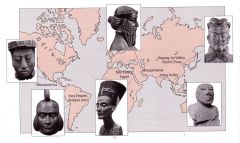
|
Cradles of Civilization Six major urban civilizations that developed relatively independently from outside influences. |
|
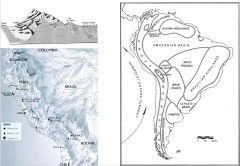
|
South America and the Andean Coast |
|
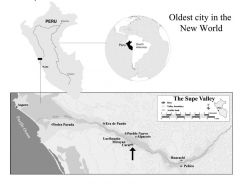
|
Caral, Peru Oldest City in the New World |
|
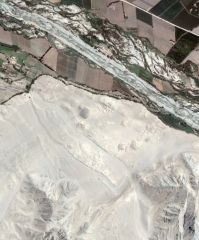
|
Caral, Peru Oldest City in the New World |
|
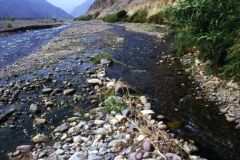
|
Caral, Peru Irrigation for cotton and other plants may have provided the source of Caral’s wealth and power. |
|
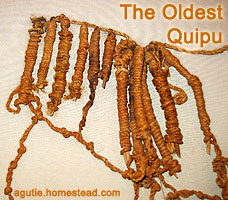
|
Caral, Peru Tradealso enriched Caral.The quipuwas a form of record-keeping that used strings and knots to encode information. |
|

|
Caral, Peru |
|
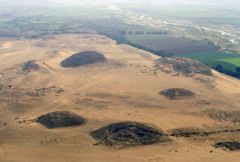
|
Caral, Peru Largestof the platform mounds is about 450’ x 500’. Central plaza area coversapproximately 150 acres. Lower-class residents probably lived on the outskirtsof the city and elite families in or near the central plaza. |
|
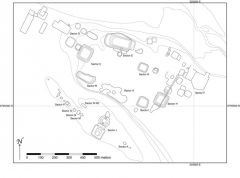
|
Caral, Peru Largestof the platform mounds is about 450’ x 500’. Central plaza area coversapproximately 150 acres. Lower-class residents probably lived on the outskirtsof the city and elite families in or near the central plaza. |
|

|
Caral, Peru Eachof the major platforms supported ritual rooms on its summit and was accompaniedby an adjoining residential complex. |
|

|
Caral, Peru Majorstructures consisted of cut-stone exterior walls and rubble infill. |
|
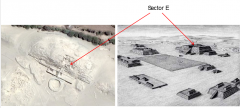
|
Caral, Peru Platformmound with circular plaza becomes common feature of Andean ceremonial sites. Left image is of Sector E, the site of the largest ofthe pyramid-platforms. |
|
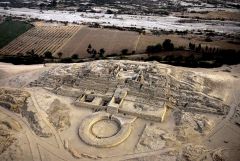
|
Caral, Peru |
|
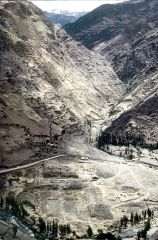
|
Chavín de Huántar, Peru. Chavín de Huántar is amajor highland site located atconfluence of rivers. |
|

|
Chavín de Huántar, Peru. Chavín de Huántar is a major highland site located at confluence of rivers. |
|

|
Chavín de Huántar, Peru OldTemple is built as a U-shaped building around a sunken circular court. Laterthe New Temple is added to the left side and a new axial sequence of elementsis built. |
|
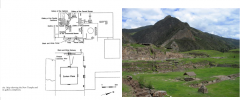
|
New Temple. Chavín de Huántar, Peru Enlargement of temple creates axial path from low to high including Black and White Stairway and Black and White Portal. |
|
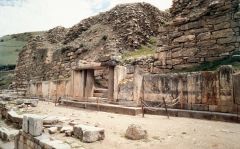
|
Black and White Portal New Temple. Chavin de Huantar. Peru Black and White Steps and Portal suggest importance of balance. |
|
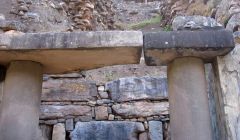
|
Black and White Portal New Temple. Chavin de Huantar. Peru Black and White Steps and Portal suggest importance of balance. |
|
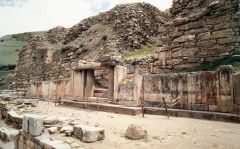
|
Black and White Portal New Temple. Chavin de Huantar. Peru Black and White Steps and Portal suggest importance of balance. |
|
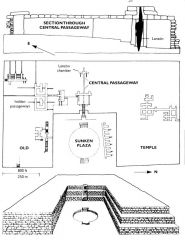
|
Old Temple. Chavin de Huantar. Peru Moundand circular sunken plaza continue older traditions. Ventilationshafts and drains form sophisticated system; may also have had ritualsignificance through sound.Atheart of temple is the Lanzónchamber. |
|
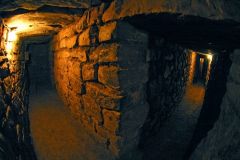
|
Old Temple. Chavin de Huantar. Peru Moundand circular sunken plaza continue older traditions. Ventilationshafts and drains form sophisticated system; may also have had ritualsignificance through sound.Atheart of temple is the Lanzónchamber. |
|

|
Old Temple with Lanzon. Chavin de Huantar. Peru Central image functions as axis mundi, or pivot linking heavens, earth, and underworld. |
|
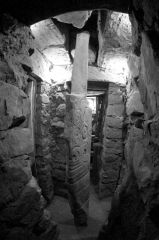
|
Old Temple with Lanzon. Chavin de Huantar. Peru Central image functions as axis mundi, or pivot linking heavens, earth, and underworld. |
|

|
Old Temple with Lanzon. Chavin de Huantar. Peru. Central image functions as axis mundi, or pivot linking heavens, earth, and underworld. |
|
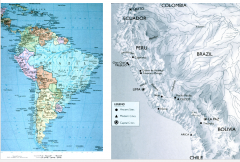
|
South America and Andean Coast |
|
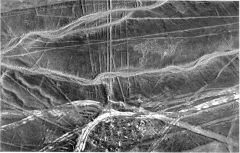
|
The Nazca Lines Lines and Orca. Nazca Plain, Peru |
|
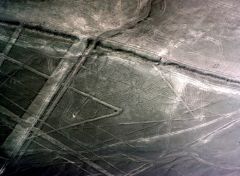
|
The Nazca Lines Lines and Orca. Nazca Plain, Peru |
|
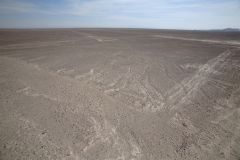
|
Nazca Plain, Peru Figures were made by clearing the surface layer of earth and rock from the lines, revealing the lighter material beneath. |
|
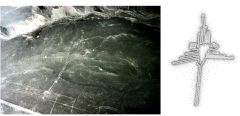
|
Humming Bird. Nazca Plain, Peru. Why create figures not easily seen by human eyes? (Meant for the Gods) Although some lines are easily visible from eye level, the zoomorphic figures can be understood only from the air. |
|
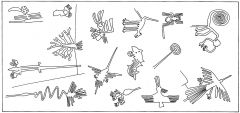
|
Animal-shaped figures. Nazca Plain, Peru. |
|
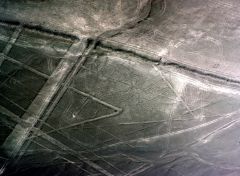
|
Spider Figure. Nazca Plain, Peru. |
|
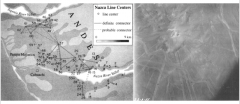
|
Nazca Plain, Peru Researchers have determined that the majority of geometric figures are related to one or more of about 60 radial centers on the Nazca plain. |
|
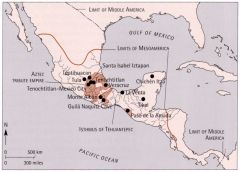
|
Mesoamerica Mesoamerica is a large region with many cultures, but some characteristics are shared by many peoples: deities, ball game, calendar, maize cultivation. |
|
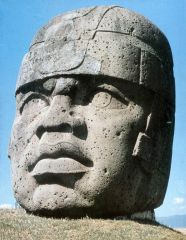
|
The Olmecs and La Venta. Colossal Head. San Lorenzon, Mexico. Olmecs often called 'mother culture' of Mesoamerica. |
|
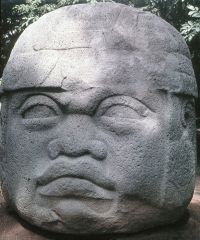
|
The Olmecs and La Venta Colossal Head. La Venta, Mexico. Olmecs often called 'mother culture' of Mesoamerica. |
|

|
La Venta. Mexico. Major ceremonial Olmec site oriented towards mountains to south, which are sacred site and also source of stone. |
|
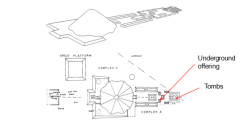
|
La Venta. Mexico. The pyramid may be the First True Mountain, the site of the first humans. |
|
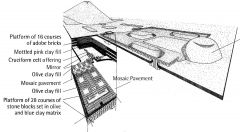
|
La Venta. Mexico. Relation to underworld is important; visibility to earthly humans is not. |
|
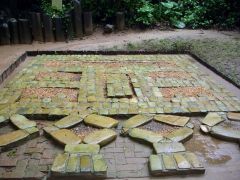
|
Buried Mosaic. La Venta. Mexico. Double merlon motif represents gate, here probably a portal between natural and supernatural space. |
|
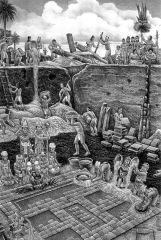
|
Buried Mosaic. La Venta. Mexico. Double merlon motif represents gate, here probably a portal between natural and supernatural space. |
|
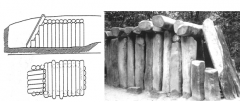
|
Tomb. La Venta. Mexico. Use of basalt carried from volcanic mountains to La Venta shows mastery of material, transportation, and land. |
|
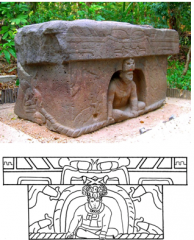
|
Throne. La Venta. Mexico. Shows ruler emerging from recess, perhaps representing underworld. Note avian headdress, sky and earth motifs, double merlon motif, jaguar motif. |
|
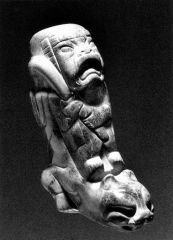
|
Throne. La Venta. Mexico. Shows ruler emerging from recess, perhaps representing underworld. Note avian headdress, sky and earth motifs, double merlon motif, jaguar motif. |
|
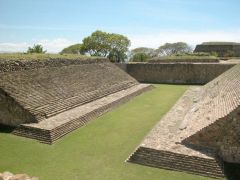
|
Monte Alban. Ballcourt. Monte Alban. Mexico Ballcourt and ball game are common to Mesoamerican cultures. First known ballcourt dates from about 1500 BCE. |
|
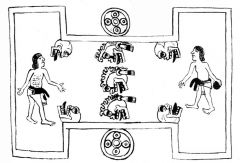
|
Monte Alban. Ballcourt. Monte Alban. Mexico Ballcourt and ball game are common to Mesoamerican cultures. First known ballcourt dates from about 1500 BCE. |
|
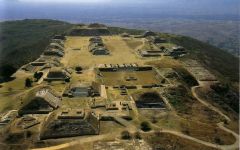
|
Monte Alban. Mexico. Largest Zapotec site and Zapotec center for over 1000 years; shows many common attributes of Mesoamerican culture and architecture. |
|
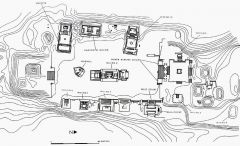
|
Monte Alban. Mexico. In a relatively short period of time from about 600 BCE to 400 BCe, MOnte Alban attracts villagers from the area to grow into a major city; this is a new type of settlement in the region. |
|
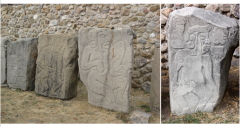
|
Monte Alban. Mexico. The most famous images from Monte Alban are the 'Danzantes', which are actually thought to be depictions of prisoners or victims of war. |
|

|
Monte Alban. Mexico. View from North Platform and South Platform Buildings recreate the literal and conceptual landscape of the mountains and valleys around Monte Alban. |
|
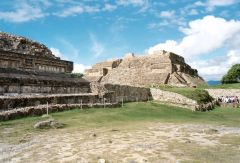
|
Complex M | Monte Alban. Mexico Plaza and stepped platform/pyramid is a common layout in Mesoamerica. |
|
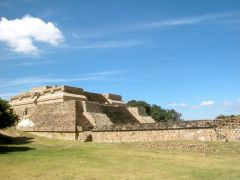
|
Complex M | Monte Alban. Mexico Plaza and stepped platform/pyramid is a common layout in Mesoamerica. |
|
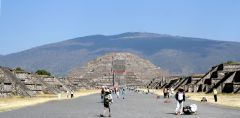
|
Teotihuacan. Mexico The greatest city in pre-Columbian Americas, and at its one of the largest in the world. Names by the much-later Aztecs as "city of gods." |
|
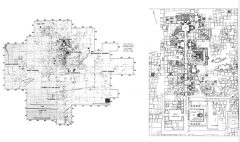
|
Teotihuancan. Mexico |
|

|
Street of the Dead an Pyramid of the Moon. Teotihuacan. Mexico. |
|
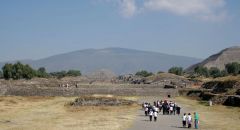
|
Street of the Dead an Pyramid of the Moon. Teotihuacan. Mexico. |
|

|
Pyramid of the Sun Teotihuacan. Mexico About 735' at base, 245' tall - a temple may have existed on top. |
|
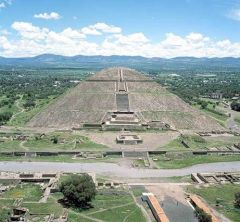
|
Pyramid of the Sun Teotihuacan. Mexico About 735' at base, 245' tall - a temple may have existed on top. |
|

|
Pyramid of the Sun. Teotihuacan. Mexico. View from the base. |
|

|
Pyramid of the Sun. Teotihuacan. Mexico. View from the summit. |
|

|
Grotto under Pyramid of theSun. Teotihuacán. Mexico. Lavatube under the Pyramid of the Sun forms a cave that was artificially enlarged.May have been seen as place of origin of humans, an idea common in laterMesoamerican cultures. |
|
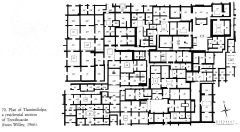
|
Apartment complex. Teotihuacán. Mexico. Until 3rd century CE, most residents live in buildings of wood and brick. Then a change to stone apartment complexes - about 2000 are constructed. |
|
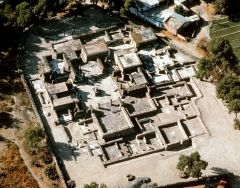
|
Residences. Atetelco complex Teotihuacán. Mexico. Apartmentcomplexes probably organized by kin groups and occupation, housing 20-150people. |
|
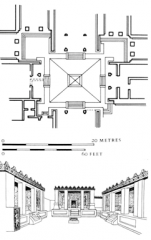
|
Residences. Atetelco complex Teotihuacán. Mexico. Apartment complexes probably organized by kin groups and occupation, housing 20-150 people. |
|

|
Teotihuancan. Mexico. Reconstruction of an apartment compound showing murals and art. |
|
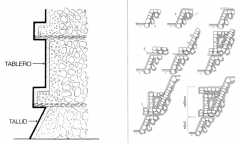
|
Talud-Tablero Talud tablero is a common architectural motif in Mesoamerica, appearing first in Teotihuancan. |
|

|
Teotihuacan. Mexico. View of 'Citadel' looking West. |
|

|
Citadel. Teotihuacan. Mexico. Differentspatial strategy than earlier pyramids–an enclosed plaza surrounded by a broadembankment and 15 pyramidal platforms. |
|
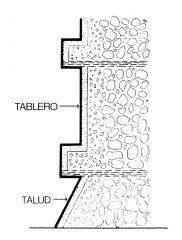
|
Temple of the Feathered Serpent (partially uncovered at right). Teotihuacán. Mexico Temple of Feathered Serpent is behind the later platform seen to its left. |
|
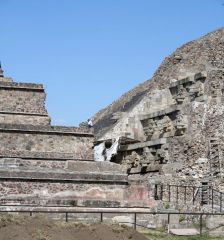
|
Temple of the Feathered Serpent(partially uncovered at right). Teotihuacán. Mexico Templeof Feathered Serpent is behind the later platform seen to its left. |
|

|
Temple of the FeatheredSerpent. Teotihuacán. Mexico Imagesin vertical tablero area and sloping taludarea. |
|

|
Temple of the Feathered Serpent. Teotihuacán. Mexico. |
|

|
Temple of the Feathered Serpent. Teotihuacán. Mexico. Masssacrifice suggested by large-scale burials under temple. At center, 20 malesburied with extravagant grave offerings. Number 20 may relate to calendar. |
|
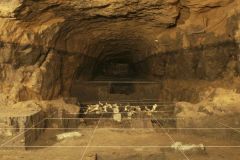
|
Temple of the Feathered Serpent. Teotihuacán. Mexico. Inthe past couple of years, archaeologists excavating a tunnel first discoveredin 2003 have made remarkable finds: “glitter-covered” walls, liquid mercury,and three chambers that may be a royal tomb. |
|

|
Temple of the Feathered Serpent. Teotihuacán. Mexico. Inthe past couple of years, archaeologists excavating a tunnel first discoveredin 2003 have made remarkable finds: “glitter-covered” walls, liquid mercury,and three chambers that may be a royal tomb. |

